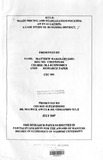| dc.description.abstract | The study was based on the maize pricing and stabilization policies. The area of study was Bungoma District. Bungoma District is located in the northern part of Western Province, Kenya .The average altitude is 1400 meters above sea level. The district covers an area approximately 2068.50 sq. km. and lies about 1 degree north of the equator. Depending on closeness to the Equator, temperatures do range from 16 degrees Celsius in the north to approximately measure 30 degrees Celsius in the southern parts of the district (GOK 1997). The area is mainly agricultural. It receives ample rainfall distributed in a bi-modal form with a working of up to 1000mm coming in the long rains season between March to July while about 500mm comes in short rain season between August to October.
The study objectives were to analyze maize price instability in Bungoma District with the view of evaluating the effectiveness of price stabilization policies overtime, to analyze the factors causing farm income instability on maize farms in the District and to find ways in which government intervention to stabilize domestic maize prices can be designed to stimulate rather than retard competitive. This was necessitated by the urge by the maize farmers is to derive good earnings on the resultant surplus maize volume over and above their subsistence levels, increase profit margins and incomes in maize farming.
The methodology of study involved both descriptive and time series analysis. Data collected covered ten years period, 1996 to 2006. The study relied mainly on secondary data sources in order to obtain the wide range of information required. The problem with primary data was that most farmers do not keep proper records and it may be difficult for them to recall information ten years ago.
VII
The findings indicated that Input Cost per Ha has a negative and a significant relationship with the number of hectares under maize per annum. This could be attributed to the fact that when cost of input per ha increases, resources to invest become more scarce hence less production anticipated meaning less land allocated to maize production. The previous year’s average farm gate maize price per 90kg bag is significant and positively related with the number of hectares under maize per annum. The previous year’s last quarter average farm gate maize prices per 90kg bag are also significant and positively related to the number of hectares under maize per annum. The Previous year’s yield per ha has a positive and a significant relationship with number of hectares under maize per annum.
The previous year’s average farm gate maize price per 90kg bag, previous year’s last quarter average farm gate maize prices per 90kg bag and Previous year’s yield per ha are therefore positively related to the number of hectares under maize per annum.This could attributed to the fact that an Increase in expected price of output and expected yield increase would (holding other factors constant) lead to more investment in terms of area under maize.
The trend analysis indicates that over the years the prices of maize have varied. The month of June seems to be witnessing high prices over the years from 1996 to 2006 than any other month followed by October and then finally January. The year 2002 witnessed low maize prices in the month of October and January. The maize prices therefore tend to fluctuate over the years from 1996 to 2006. The yearly average prices are range
viii
between a minimum of Kshs 750 and maximum of Kshs 1400 over the years from 1996 to 2006. This trend means uncertainty serving as a deterrent to maize farming.
The study recommends that in order to encourage farmers to allocate more hectares to maize, the competitiveness and stability of the maize farm-gate price can be improved by more efficient use of storage, transport and market information.
In Gross Margin analysis, prices as per Ministry of Agriculture crop valuation remains constant around kshs 1000 per 90kg bag while the breakeven price average stays above Kshs 1000 per 90 Kg bag of maize. This implies that most of the years from 1996 to 2006 farmers experienced losses.
The study would therefore wish to recommend that In order to improve the number of hectares under cultivation; the agricultural policy makers should look into the cost of inputs such as fertilizers and others with a view of lowering them so that farmers can increase the number acreage under maize cultivation. This will encourage the farmers to have the morale in farming maize and therefore reduce the food insecurity.
The upgrading of Sikata—Kimilili road should be speeded. More access roads to interconnecting the interior rural in the ten divisions in Bungoma District need to be upgraded to tarmac level. More funds through the constituency roads Development Fund need to be set aside for this purpose. Good roads have potential lower the transport per
IX
unit transport cost. This incentive can encourage maize farmers to use transport to access markets that would offer competitive prices for their output.
The Ministry of Agriculture should be allocated more funds for collaboration with Non Governmental Organizations such as SACRED Africa among others. This will enhance the level of market information and organization among maize farmers. An organized and informed farmer has a better level of bargain both for his inputs and outputs.
In 2007/2008 financial year, just over 4% of National budget was allocated to agriculture which employs over 70% of the total labor force and contributes about 20% of the Gross Domestic Product.
The Constituency Development Fund committees in the five constituencies in Bungoma District should each set aside a revolving fund to give affordable credit to farmers to assist finance input costs, support storage, transportation and marketing activities of the maize commodity. | en_US |



